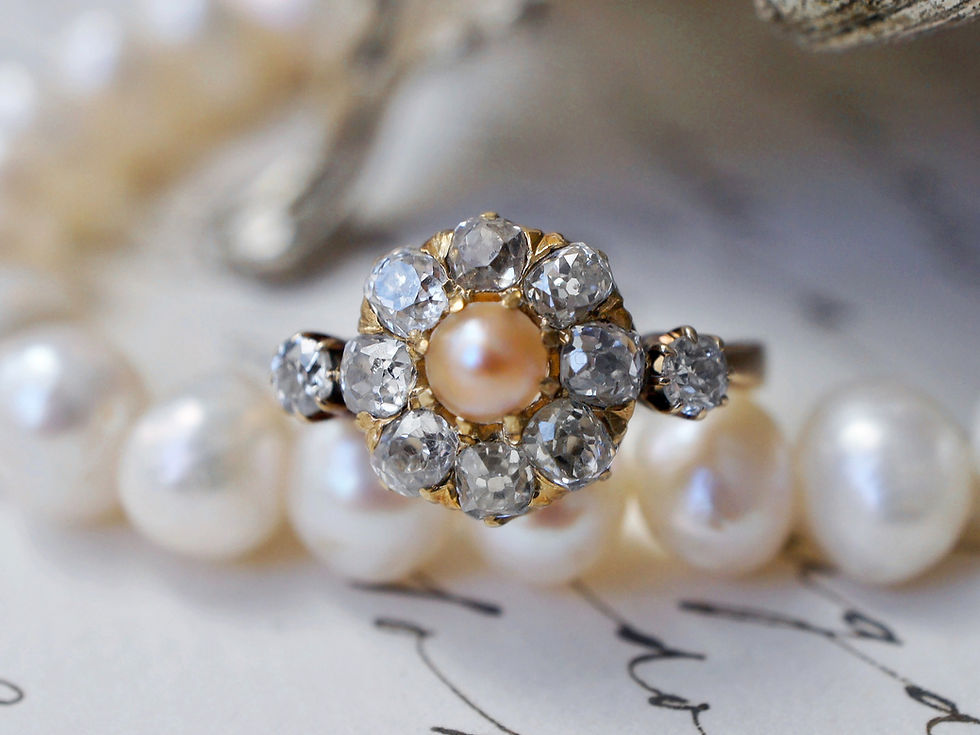Natural Pearls vs. Cultured Pearls
- rsandberg
- Dec 18, 2021
- 3 min read
In this blog we'll be exploring the differences between natural and cultured pearls. The behind-the-scenes processes that occur to produce these pearls are truly remarkable. Researching and learning about this section of the gemstone / antique jewellery industry has given me a real appreciation for both nature and us humans, who create these techniques in order to replicate natural processes. Either way, natural or cultured, a lot of time and effort has been devoted to these pearls.

How do natural pearls grow?
Pearls are produced in a type of shellfish, molluscs. These include saltwater oysters and freshwater mussels. A pearl is formed when a foreign matter enters the mollusc, if this then gets stuck inside this irritates the mollusc, causing it to create a sac around the foreign matter to protect itself. This sac is known as nacre. The nacre builds layers overtime, the more layers, the bigger the pearl. These layers are affected by various factors such as seasonal growth and temperature. Crazy, right!
The common round-shaped pearl is formed inside of the body of a mollusc, otherwise known as cyst pearls. Blister pearls form on the inside of the shell and need to be sawn away from the shell in order to release them.

How are cultured pearls produced?
With cultured pearls, the process involves using a part of the inner mantle from another oyster, usually in the shape of a bead, to start off the production of a pearl in another oyster; this is called tissue nucleation. The mollusc reacts to this foreign object and builds a nacre covering around it, thus creating a pearl.
This industry changing method was introduced by Mikimoto, a Japanese man, in 1893, and by 1900 it had flooded the market, decreasing the value of natural pearls in its wake.

Durability
Pearls are can be damaged easily by detergents, soaps and cosmetics. For this reason, when dressing, pearls should always be put on last, to avoid damage from any lingering perfumes or chemicals on the skin.
One of the most famous stories comes from ancient Egypt, where the powerful Cleopatra is said to once have dissolved a priceless pearl in red wine and drank it in a display of her wealth.
Tests to determine natural or cultured pearls
If you take a cross section of a natural pearl verses a cultured pearl, the natural pearl reveals a concentric ring like structure, much like growth rings in a tree, whereas the cultured pearl will reveal an evenly-coloured bead and thin overlying nacre layer.
Pearls are notoriously hard to identify, however field gemologists do have a few tricks up their sleeves. The most trusted field method is one called candling, where you place a bright light behind the pearl so that it illuminates the gemstone from behind; then, using a10x loupe we inspect the stone for a cultured bead nucleus, which appears like a solid mass in the centre of the pearl, if there is an absence of this solid centre then it is likely your pearl is natural.
However, if you have the equipment, the only fail safe test is to preform an X-ray. Here you will be able to clearly see whether the pearl has grown naturally with all those decades of beautiful nacre layers building up from the centre, or whether is has been cultured and has a host bead nucleus to the centre.


Lore
The soft organic beauty of pearls has made them prized by all cultures for centuries. Often said to symbolise purity, wealth and fertility, it is common to see them worn by brides on their wedding day.
Today pearls remain popular worn by royals and members of the public alike, timeless in their elegance and social message of sophistication and class.


My fav